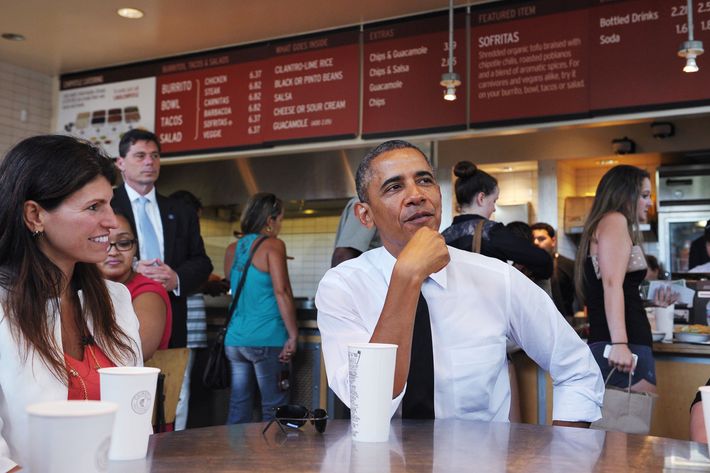
The newest meme in the 2016 campaign is the idea that Hillary Clinton is running a “narrower,” more partisan campaign than her husband did, thereby endangering her ability to govern if she wins, and possibly endangering her campaign itself. To call an idea a meme has certain insulting connotations — it implies that it spreads from person to person on the basis of its cosmetic appeal, without having any analytic heft to support it. In this case, the insulting connotation is fair.
The main basis for the meme is a mostly good front-page news analysis from Sunday’s New York Times, by Jonathan Martin and Maggie Haberman, which contrasts Hillary Clinton’s campaign strategy with her husband’s 1992 version. Centrist pundits like Ron Fournier and David Brooks have loaded Martin and Haberman’s analysis with moral connotations, producing columns that excoriate Clinton as divisive, partisan, liberal, and bad for America. The meme is powerful because it appeals to deep-seated emotions that animate centrists like Fournier and Brooks. But it is based on a series of misapprehensions about American politics piled atop each other, producing a conclusion that is bizarre and incoherent.
1. Martin and Haberman identify an important ideological difference between the current Clinton campaign and the previous version. Bill Clinton ran in 1992, during a conservative era, when most social issues favored the Republican Party. Bill Clinton adopted heterodox positions on criminal justice and welfare in order to rebuild his party’s trust with white voters, who had fled in the mid-1960s.
Hillary Clinton, on the other hand, has the luxury of social issues that unite her basis with the center. The Times story correctly identifies her “liberal positions on gay rights, immigration, criminal justice, voting rights and pay equity for women.” The article does not mention that those positions, in addition to appealing to liberals, also appeal to the center, though Martin and Haberman have made this point in previous stories. Those liberal positions place Republicans in a bind between their base and the political center. All this is to say that Hillary Clinton, like her husband, is attempting to occupy the political center on social issues but has the benefit of more favorable terrain. One reason for this is that the electorate looks dramatically different than it did 24 years ago. In 1992, nonwhite voters constituted just 13 percent of the electorate. In 2016, they will probably cast 30 percent of the votes.
2. Hillary Clinton’s geographic targets also look very different from her husband’s. “When Bill Clinton reclaimed the presidency for Democrats in 1992, his road to the White House ran through Southern and Southern-border states filled with what were then a precious commodity: swing voters,” the article notes. “Twenty years later, Mr. Obama convincingly won a second term without competing in states like Kentucky, Louisiana, Tennessee or West Virginia that powered Mr. Clinton.”
That is true. This is because the party bases have changed significantly since that time, as part of the larger, decades-long realignment. In 1988, Democrats won West Virginia while losing California and Vermont. That is not going to happen in 2016, or anytime soon.
The Times story begins to run aground when it conflates Clinton’s geographic strategy with her ideological strategy. Martin and Haberman describe her plan as “a campaign focused more on mobilizing supporters in the Great Lakes states and in parts of the West and South than on persuading undecided voters.” Of course, Clinton’s campaign is going to try to persuade undecided voters. It’s just going to target them in places that are swing states now, like Ohio, Wisconsin, Virginia, and Florida, rather than in places that were swing states a generation ago.
Democrats in red states are not happy about Hillary Clinton’s resource-allocation strategy for obvious reasons, and they supply many of the quotes that give the Times story its critical edge. But the idea that Clinton is making a political error by avoiding states that have turned redder is the completely misguided product of the self-interest of Democratic politicians in those states. It assumes that Clinton’s personal appeal can overcome the deeper social trends that have made those states increasingly Republican. The Clintons tested that hypothesis in 2014, when Bill Clinton invested heavily in campaigning for Mark Pryor in Arkansas, and Hillary Clinton did the same for Alison Lundergan Grimes in Kentucky. Both these candidates, talented children of popular Democrats in their home states, hoped that defining themselves as “Clinton Democrats” rather than “Obama Democrats” could allow them to rekindle their states’ faded Democratic loyalties. This proved very wrong, and both candidates lost by landslides.
The Republican tilt of states like Kentucky, Louisiana, Tennessee, and West Virginia has little to do with the personal choices of the candidates who run there. West Virginia’s support for the Democrats in 1988 did not come as a result of Michael Dukakis’s deep personal bond with the Appalachian heartland. Nor did Dukakis’s strategy represent a more centrist approach than Hillary Clinton’s. It was just a different map.
3. Martin and Haberman likewise go off track when they contrast Bill Clinton’s “nationwide electoral strategy,” as they call it, with Obama’s “narrower” one. Obama won a higher percentage of the vote in both his races than Bill Clinton won in either — indeed, Clinton, unlike Obama, never won an outright majority. It is true that Clinton won by larger margins than Obama did, and consequently won more states in the electoral college. But this is largely due to his benefiting from the third-party candidacy of Ross Perot, who took more votes from the Republicans than the Democrats.
Bill Clinton did not run a more “nationwide” campaign than Obama. He ran a campaign aimed at different targets, which enjoyed the benefit of a center-right splinter candidate. The Times story mentions numerous states contested by Clinton but not Obama. It does not mention the reverse. It’s worth noting that Bill Clinton lost Florida once and Virginia and North Carolina twice, whereas Obama won Florida and Virginia twice and split North Carolina.

4. The Times article, Brooks, and Fournier all suggest that Hillary Clinton’s electoral strategy will inhibit her ability to govern. Fournier (“If the next president hopes to pass any actual laws, he or she will have to create a bipartisan governing majority”) and Brooks (“this base mobilization strategy is a legislative disaster”) have especially passionate views about this.
Yet none of the stories explain how this connection works. The usual centrist pundit formula holds that a president who wins narrowly lacks a “mandate” and therefore must govern from the center. Now the pundits are arguing that a sweeping landslide victory is necessary in order to govern from the center.
But history provides no reason to imagine there is any logical connection between the scope or style of a candidate’s campaign and subsequent legislative success. The Times holds up Bill Clinton’s 1992 campaign as the counterexample to Hillary Clinton’s plan. But, despite his “nationwide” campaign, Bill Clinton encountered immediate, massive partisan opposition to his stimulus plan, his attempt to let gays serve in the military, his deficit-reduction program, and even his crime bill, which was largely conceived as a sop to the center.
Fournier strangely writes, “Barack Obama managed to run a campaign in 2008 that leveraged his demographic advantages while appealing to a broad swath of the electorate,” then laments that “he didn’t follow through.” He fails to grasp the obvious conclusion: Running a unifying campaign that downplays partisan themes has nothing to do with governing.
5. Brooks, in his column, further confuses matters by concluding that the Clinton campaign is abandoning “moderates.” (He writes, “Politics is broken today because those sorts of leaders have been replaced by highly polarizing, base-mobilizing politicians who hew to party orthodoxy, ignore the 38 percent of voters who identify as moderates and exacerbate partisanship and gridlock.”)
The original Times story says nothing of the sort, and Brooks appears to be conflating moderates with true independent voters. In fact, even while losing self-identified independents in 2012, Obama won self-identified moderates handily. Many more Americans self-identify as conservative than liberal — though the gap has shrunk recently — making the winning of moderates a necessary component of nearly any winning Democratic campaign.
6. Even more strangely, Brooks goes on to argue not just that Hillary Clinton’s electoral strategy is less moral and injurious to her chances of governing, but that it is unlikely to succeed:
The Clinton mobilization strategy is based on the idea that she can generate Obama-level excitement among African-American and young voters. But as Philip Klein documented in The Washington Examiner, Obama was in a league of his own when it came to generating turnout and support from those groups. If Clinton returns to the John Kerry/Al Gore level of African-American and youth support, or if Jeb Bush or Marco Rubio can make inroads into the Hispanic vote, then the whole strategy is in peril.
Correct: If Clinton suffers a heavy drop-off among young or nonwhite voters, she is in danger of losing. That is why her campaign is focused on preventing that very thing from happening. Brooks is arguing that Clinton is stupid to focus on mobilizing the Democratic base, because if she fails to mobilize the Democratic base, she will lose. That is not how strategy works.






























